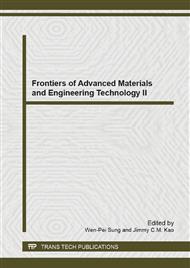[1]
Dai Yawen, Sun Mingqing, Liu Chenguo, Li Zhuoqiu, Electromagnetic wave absorbing characteristics of carbon black cement-based composites, Cement Concrete Comp. 32 (2010) 508–513.
DOI: 10.1016/j.cemconcomp.2010.03.009
Google Scholar
[2]
Cengiz Duran Atis, Okan Karahan, Properties of steel fiber reinforced fly ash concrete, Constr. Build Mater. 23 (2009) 392–399.
Google Scholar
[3]
B. Li, Y. Duan, Y. Zhang, S. Liu. Electromagnetic wave absorption properties of cement-based composites filled with porous materials. Materials and Design, 2011, 32(5): 3017-3020.
DOI: 10.1016/j.matdes.2010.12.017
Google Scholar
[4]
Sang-Eui Lee, Ji-Ho Kang, Chun-Gon Kim, Fabrication and design of multi-layered radar absorbing structures of MWNT-filled glass/epoxy plain-weave composites, Compos. Struct. 76 (2006) 397–405.
DOI: 10.1016/j.compstruct.2005.11.036
Google Scholar
[5]
H.T. Guan, S.H. Liu, Y.P. Duan, Y. B. Zhao, Investigation of the electromagnetic characteristics of cement based composites filled with EPS, Cement Concrete Comp. 29 (2007) 49–54.
DOI: 10.1016/j.cemconcomp.2006.08.001
Google Scholar
[6]
A. Oikonomou, T. Giannakopoulou, G. Litsardakis, Design, fabrication and characterization of hexagonal ferrite multi-layer microwave absorber. J. Magn. Magn. Mater, 316 (2007) 827–830.
DOI: 10.1016/j.jmmm.2007.03.114
Google Scholar
[7]
Meng W, Yuping D, Shunhua L, et al. Absorption properties of carbonyl-iron/carbon black double-layer microwave absorbers[J]. Journal of Magnetism and Magnetic Materials, 2009, 321(20): 3442-3446.
DOI: 10.1016/j.jmmm.2009.06.040
Google Scholar
[8]
Yuefang Zhang, BaoYi Li, Shunhua Liu, Wanjun Hao. Electromagnetic Wave Absorption Properties and Mechanical Properties of Aramid Fiber Reinforced Cement. Advanced Materials Research 2012, 512-515: 2873-2877.
DOI: 10.4028/www.scientific.net/amr.512-515.2873
Google Scholar
[9]
S.M. Abbas, A.K. Dixit, R. Chatterjee, T.C. Goel, Complex permittivity and microwave absorption properties of BaTiO3–polyaniline composite, Mater. Sci. Eng. B-Adv. 123(2005) 167–171.
DOI: 10.1016/j.mseb.2005.07.018
Google Scholar
[10]
ZHANG Yuefang, HAO Wangjun , DUAN Yuping, LIU Shunhua , Electromagnetic Wave Absorption Properties of Cement filled with Carbon Black, Applied Mechanics and Materials. (2013) 178.
DOI: 10.1016/j.matdes.2010.12.017
Google Scholar


